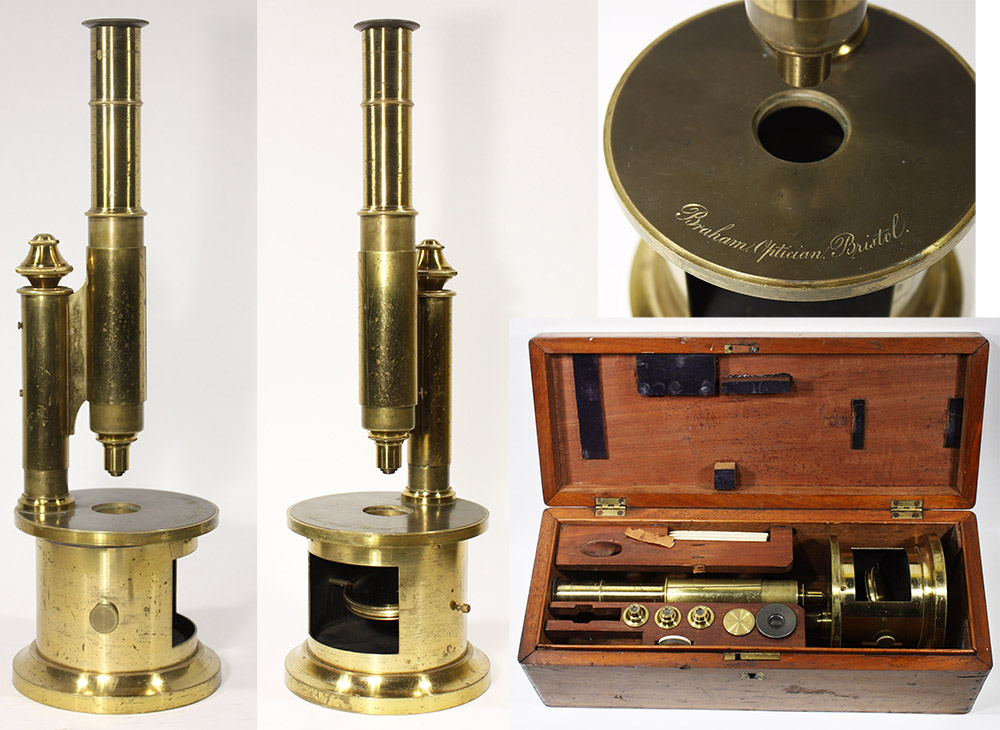
Figure 1. A ca. 1840 drum-style microscope, signed on the stage “Braham Optician Bristol”. It was almost definitely manufactured in France.
John Braham, 1799 - 1864
by Brian Stevenson
last updated March, 2025
John Braham operated an optical business in Bristol, England, from about 1828 until 1863. A number of microscopes are known that bear Braham’s name (Figures 1-3). It is highly likely that all of those instruments were produced by wholesale manufacturers in France and England, then resold by Braham under his own name. Braham’s major products were eyeglasses, designs for which he patented (Figures 4-5). From the 1850s onward, Braham also operated a wholesale eyeglass frame factory in London, managed by his sons.
John Braham formed a partnership around 1833 with a younger brother, George, who established an optician’s business in Bath. For the next two decades, advertisements and trade directory entries from both John and George often listed addresses in Bristol and Bath. However, neither brother’s advertisements/directory entries mentioned the other brother. When the partnership was dissolved in 1852, The London Gazette described it as “Braham Brothers”. That partnership is not to be confused with the “Braham Brothers” of Bath whose name appears on microscope slides and other apparatus - that business was a partnership between George Braham’s sons, in the later 1800s. George Braham’s business, and those of his sons, are described in a separate essay.

Figure 1.
A ca. 1840 drum-style microscope, signed on the stage “Braham Optician Bristol”. It was almost definitely manufactured in France.
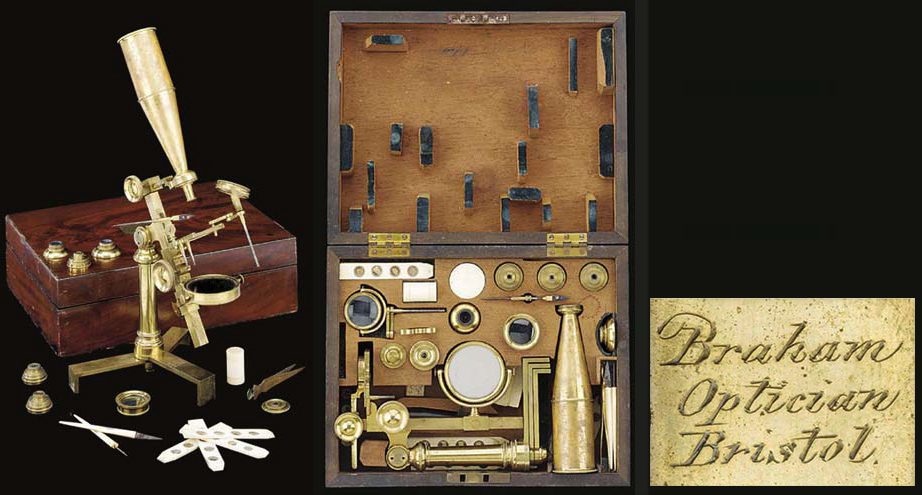
Figure 2.
Circa 1830-40 microscope, with “Braham Optician Bristol” on the foot. It was probably made by a London wholesale manufacturer. Adapted for nonprofit, educational purposes from an internet auction site.
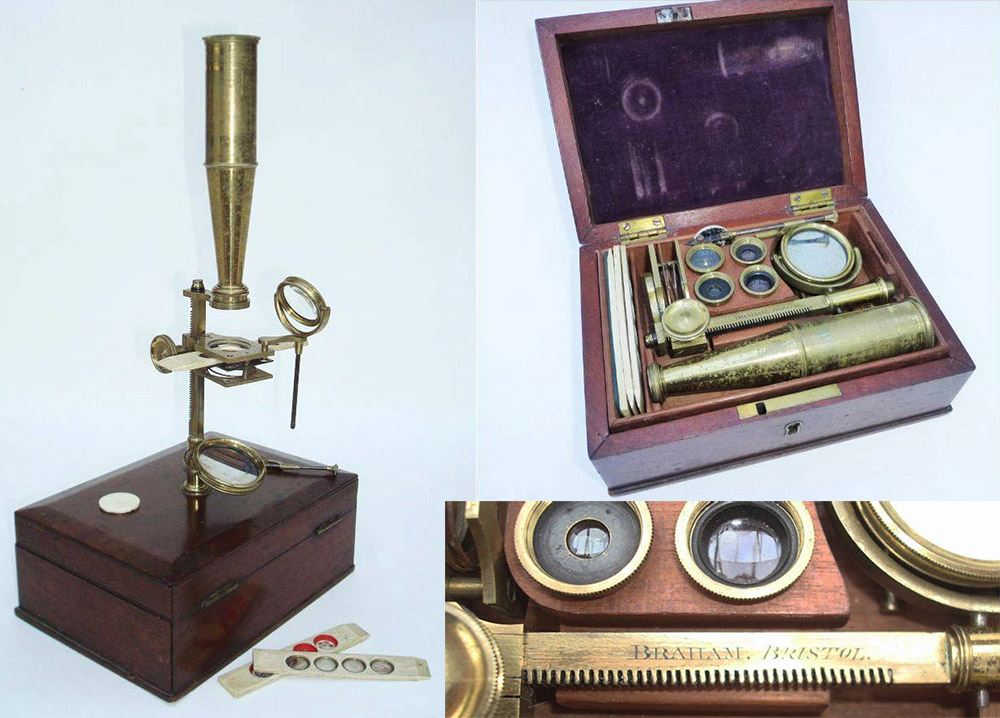
Figure 3.
Circa 1840 Gould-style microscope, signed “Braham Bristol”. Adapted for nonprofit, educational purposes from an internet auction site.

Figure 4.
Two pairs of John Braham’s patented pince nez eyeglasses, ca. 1861. Adapted for nonprofit, educational purposes from an internet auction site and from https://collection.sciencemuseumgroup.org.uk/objects/co447384/helical-spring-folding-eyeglasses-with-oval-lens-nose-spectacles-pince-nez.

Figure 5.
The illustration of eyeglass frame styles that accompanied John Braham’s 1861 patent application and award.
John Braham was born as Jacob Abrahams in 1799 in Plymouth, Devon, son of David and Rose Abrahams. His siblings all appear to have also modified their surnames to “Braham”.
The earliest identified business record of John Braham is from an 1828 commercial directory of Bristol, which listed him as “Optician; Mathematical Instrument Warehouse, 12 Clare street”. He was not listed in an 1825 directory. John would have been 28-29 years old in 1828 - presumably, he had served an apprenticeship and worked for several years as an employed journeyman before opening his own business.
An 1830 business directory records that Braham had since moved to 42 College Green, in Bristol. He was also appointed as an official distributor of Admiralty Charts, i.e. official Royal Navy navigational charts.
Prior to 1832, another move occurred, to 10 St. Augustine’s Parade. That year, Braham published a booklet that described the “science” behind a device that he had invented to “purify” household air and prevent cholera and other diseases (Figure 6). This being several decades before general acceptance of the germ theory, it was commonly thought that diseases were spread through air contaminated by “foul or deleterious vapours”. Unfortunately, Braham did not describe the machine, nor provide an illustration. As were many other scientific instrument makers, Braham was very interested in magnetism and electricity for medical purposes (Figure 7), so his device may have been some combination of the two. Perhaps a sparking device that produced ozone?
Younger brother George left Bristol for Bath in 1833, and established an optical and scientific shop there. As noted above, John and George had some sort of business partnership, with each citing both addresses in their advertisements, although each used only his own name for their shop.
Braham published a “Catalogue of Mathematical and Optical Instruments, Philosophical and Other Apparatus” in 1837, in the back of his book on “Outlines of the Science of Magnetism, Electro-Magnetism, Voltaic, Thermo, and Magneto-Electricity” (Figures 7-8). Microscopes were evidently a small part of Braham’s inventory. He offered “small” and “large compound microscopes” with prices ranging from £3 3s to £12 12s, which could encompass each of the instruments shown in Figures 1-3, above. Solar and lucernal microscopes were available by special order, implying that the market in Bristol was not sufficient for Braham to keep those instruments in his inventory. A variety of simple magnifiers rounded out his selection, including “flower microscopes” see this site’s essay of W. & S. Jones, Figure 13 for illustrations.
At some point, John Braham also formed a partnership with Jacob Jackson (or his heir). Jackson is recorded as a “watch maker, engraver” in Bristol as far back as 1785. By 1823, his business was known as “J. Jackson & Son”, located at 17 St. Augustine’s Parade. Some authors have suggested that Braham took over Jackson’s business in the 1820s, but historical documents argue otherwise: the Braham shop and the Jackson shop existed simultaneously, each at a different address. An 1836 directory of Bristol lists “Braham John, Optician ; Mathematical, Philosophical, & Nautical Instrument maker, 10 St. Augustine’s parade, Agent for the sale of the Charts & Plans published by the Lords Commissioners of the Admiralty” and “Jackson J. & Son, Goldsmiths Jewelers, Chronometers, Watch & Clock manufacturers, &c. Observatory, 17 St. Augustine’s parade, nearly opposite the drawbridge”. Jacob Jackson died in early 1838. The following year, The London Gazette announced the dissolution of the partnership between Arthur Jackson and John Braham, “Watch-Makers and Jewelers … under the firm of Jackson and Braham” (Figure 9). This suggests that the partnership was actually between Braham and Jacob’s son, and may have formed around the time of Jacob Jackson’s death. However, John Braham married Jacob Jackson’s daughter, Henrietta, around the time he opened his shop (the date of their marriage is not known, but their first child was born in 1829). John may have had a financial arrangement with his father-in-law.
The 1839 notice of dissolution stated that “the business will be carried on by said John Braham alone” (Figure 9). An advertisement from August, 1839, for “John Braham and Co., Working Opticians, Manufacturers of all kinds of Mathematical, Philosophical, and Nautical Instruments” provided the Bristol address of 17 St. Augustine’s Parade. Thus, Braham had moved from his previous shop, at number 10, into Jackson’s space. The advertisement also listed brother George’s shop at 5 York Buildings, Bath, and a third address is Swansea (I have not found any further information about the Swansea shop). The inclusion of “and Co.” in the business name may reflect John’s partnership with George, or it may indicate financial involvement by other people.
Braham was awarded patents for his designs of eyeglass lenses and frames by 1845 (Figure 11). They were distributed throughout the country by other opticians (Figures 11-12).
A new engineering tool, the “Trigonometer”, was announced by Braham in 1849 (Figure 13). His booklet advertised its usefulness for “engineers, surveyors, architects and builders, and for draining, mining, geological and other purposes”.
John Braham exhibited the trigonometer and a wide variety of eyeglass items at the 1851 International Exhibition in London (Figure 14).
In 1852, The London Gazette announced the dissolution of the Braham Brothers’ optician partnership. Presumably, this was the end of the apparent business agreement between John and George. George died in 1865, and his business in Bath was continued by two sons as “Braham Brothers”.
Another set of patents for eyeglasses were awarded to John Braham in 1861 (Figure 5).
Probably around the middle of 1863, John and family moved to London. All of his sons were already living there, some involved with the wholesale eyeglass factory, and others pursuing other careers. Perhaps as a move to finance his retirement, John auctioned off the scientific instruments from his shop: “telescopes, microscopes, levels, sextants, and other surveying instruments, opera and race glasses, thermometers, barometers, magic lanterns and slides, air pumps, quadrants, compasses, lenses, drawing instruments, &c.” (Figure 16). Notably, nothing related to eyeglasses was mentioned in the auction announcement.
John Braham died the next year, on November 25, 1864
The Braham optical business in Bristol continued to operate, under the ownership of John’s sons. One of their London employees, Matthew William Dunscombe (1841-1918), was sent to Bristol to manage the shop. A native of Bristol, Dunscombe had apprenticed with John Braham, then was sent to London to work in the wholesale factory. The 1871 census shows Dunscombe and his family living at the Braham shop on St. Augustine’s Parade. He purchased the Bristol business from Braham’s heirs in 1874, then operated it into the twentieth century. A separate essay on Matthew Dunscombe is forthcoming.

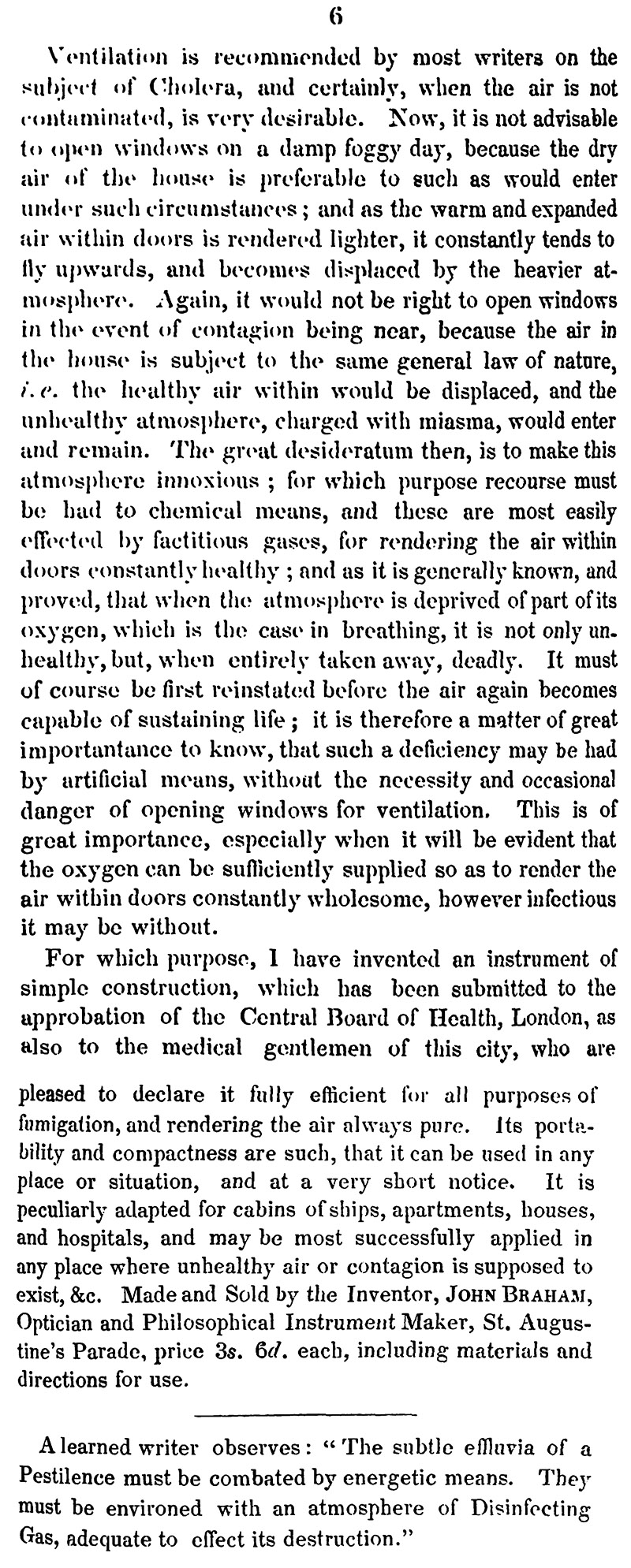
Figure 6.
The cover and an excerpts from John Braham’s 1832 “Preventive for Cholera Morbus”.
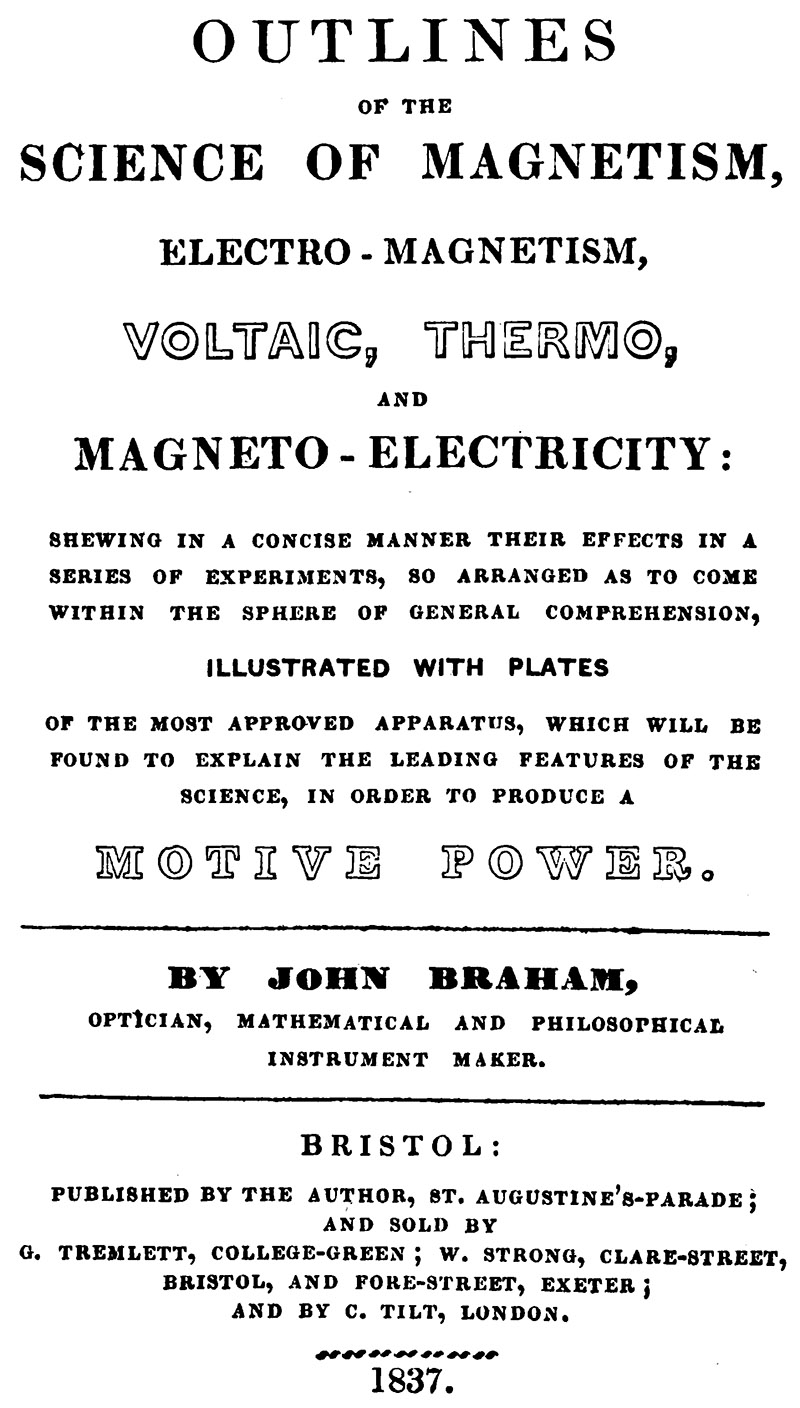
Figure 7.
The cover of John Braham’s 1837 “Outlines of the Science of Magnetism, Electro-Magnetism, Voltaic, Thermo, and Magneto-Electricity”.
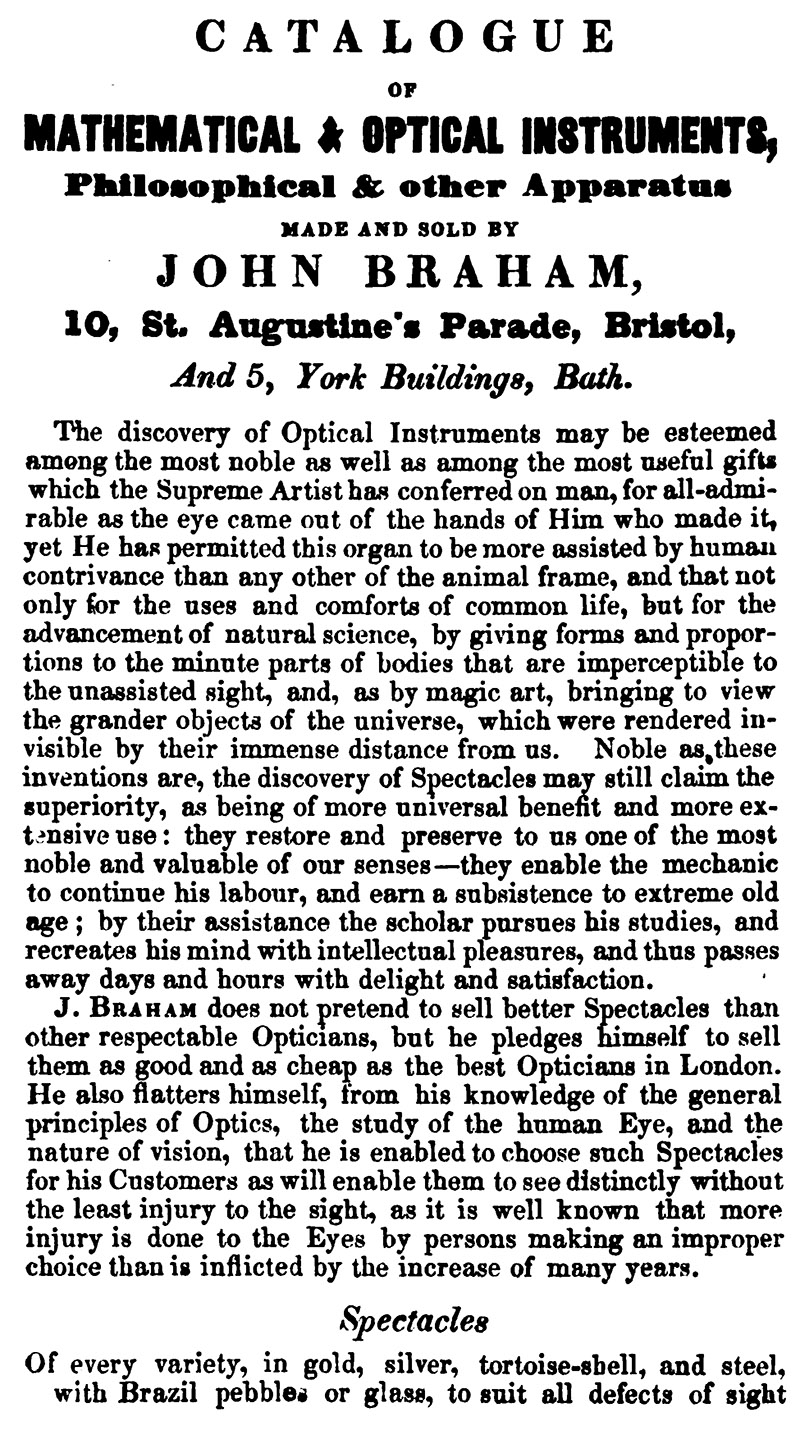
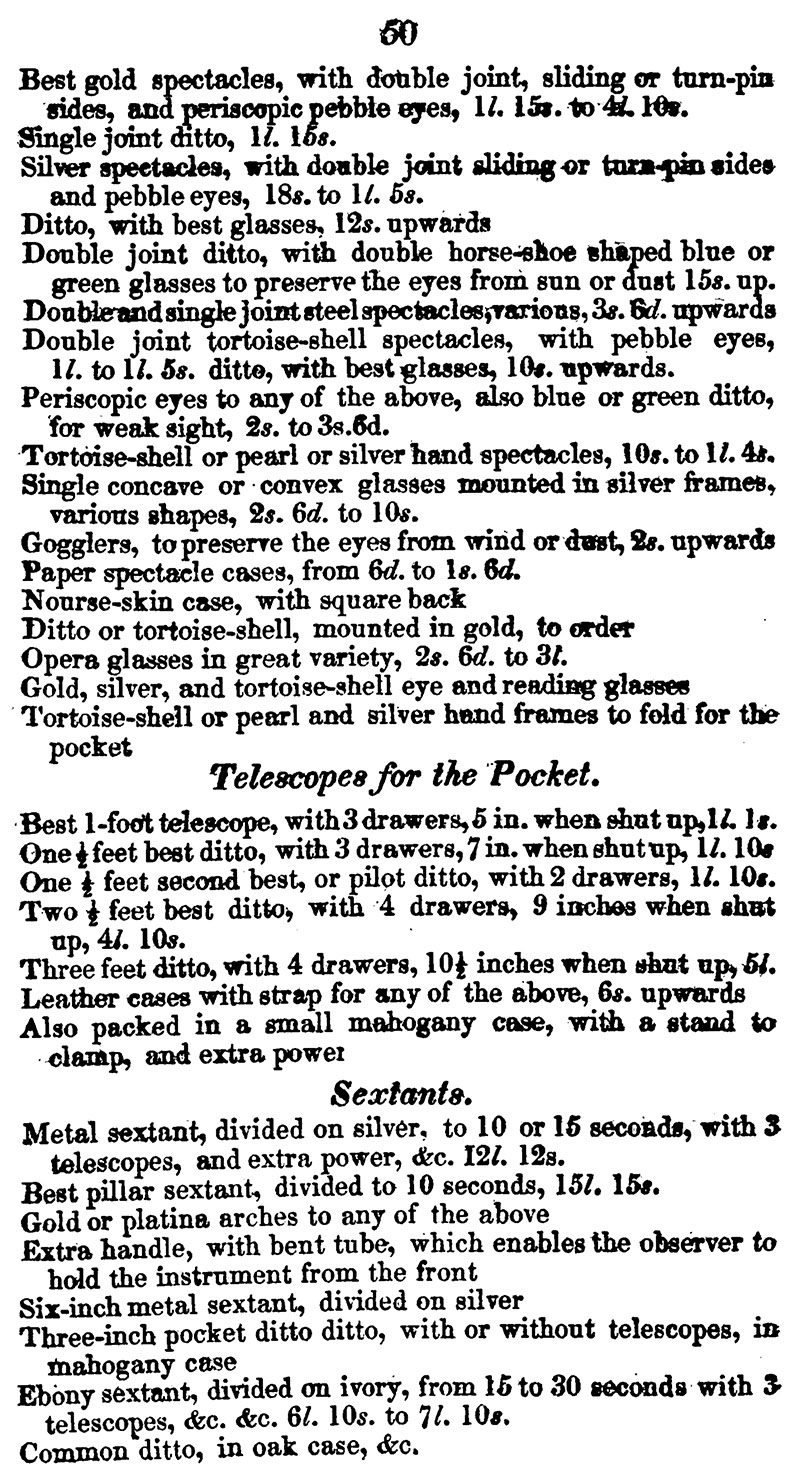
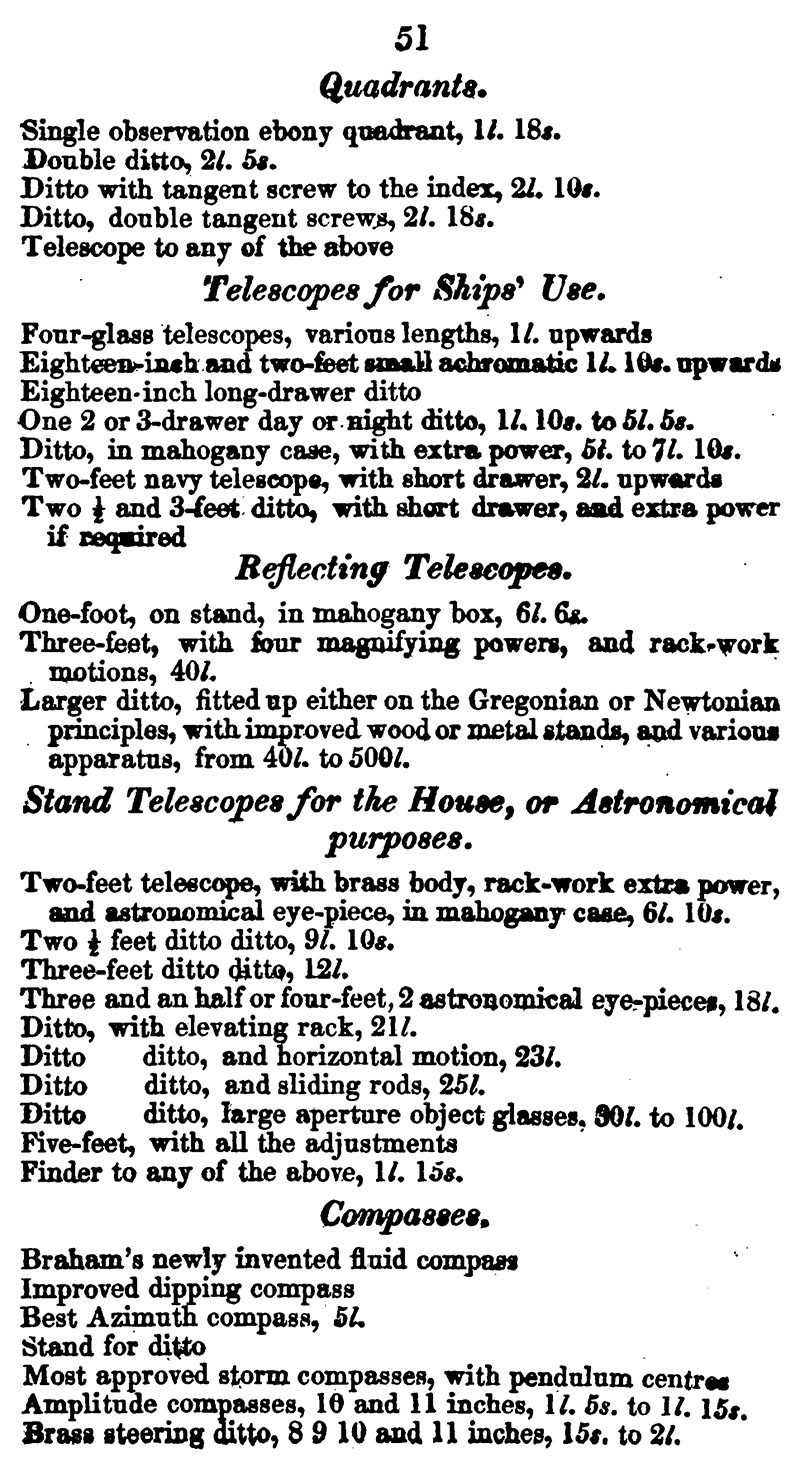
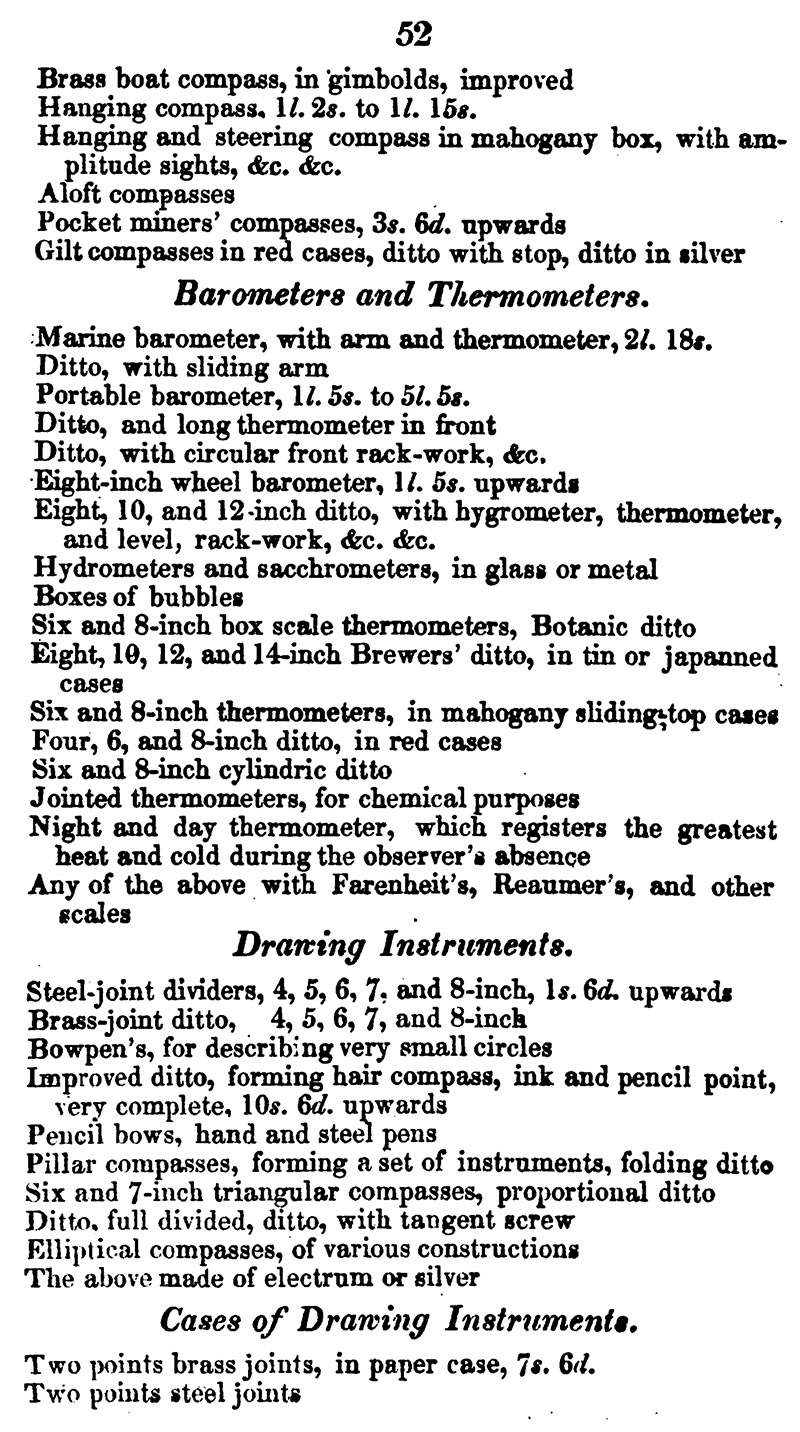
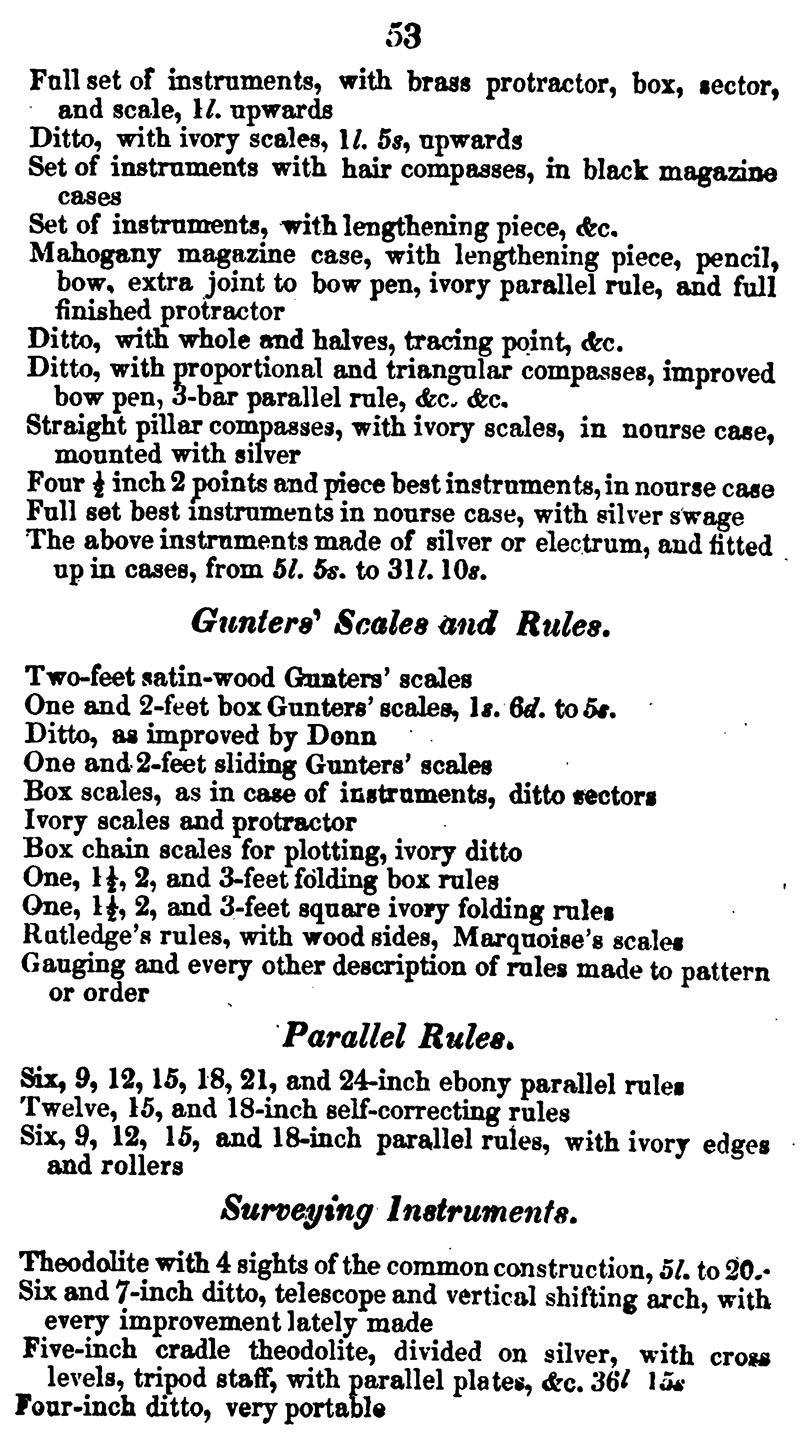
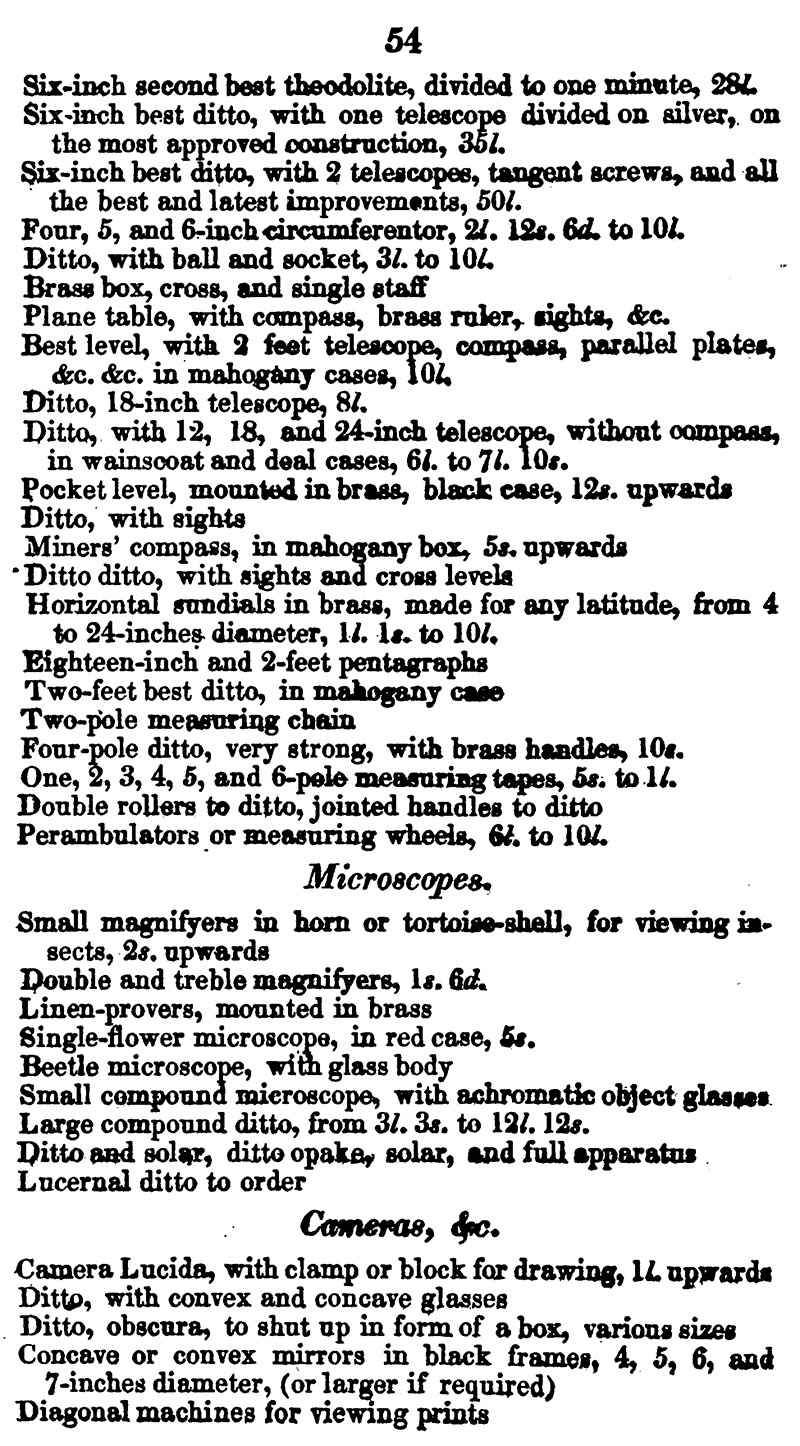
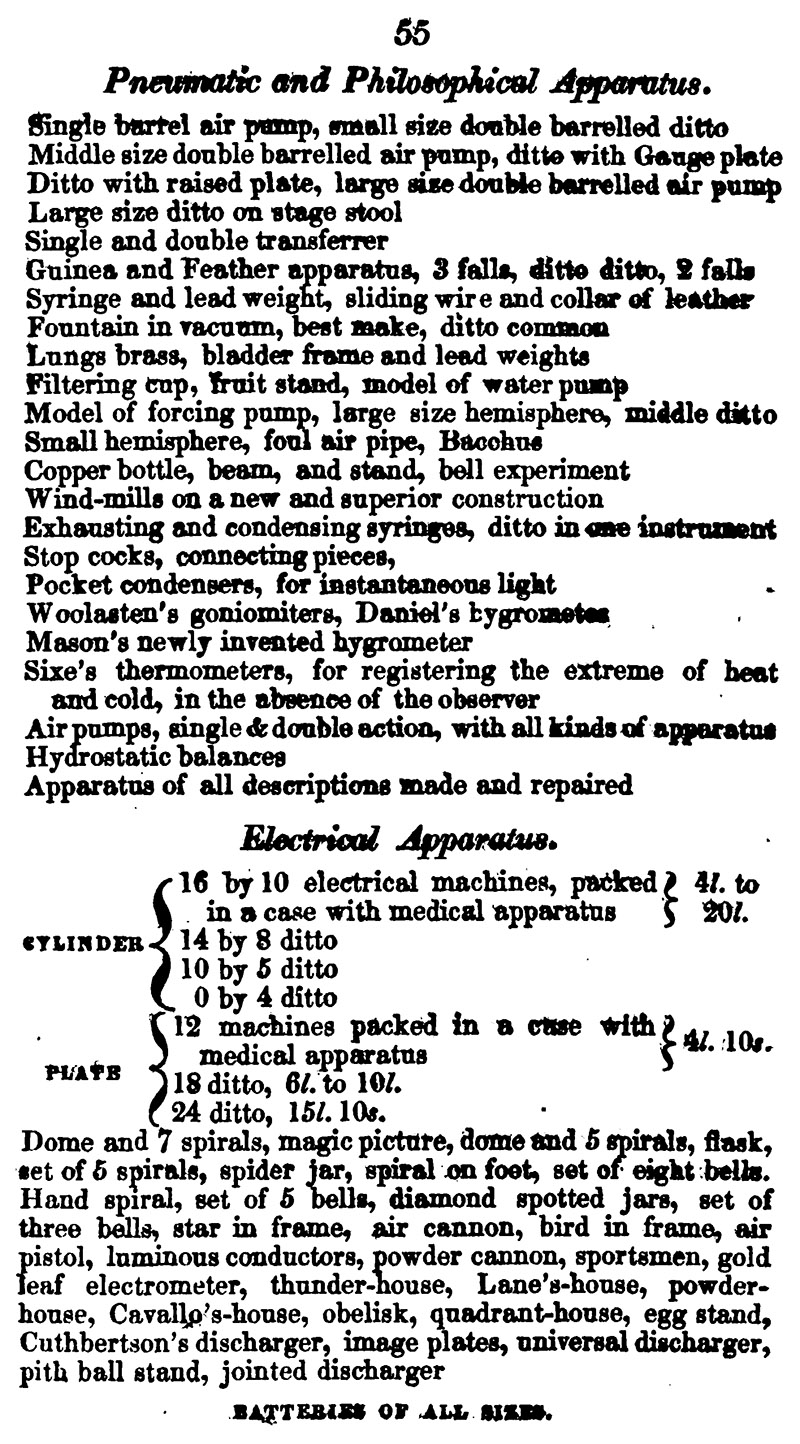
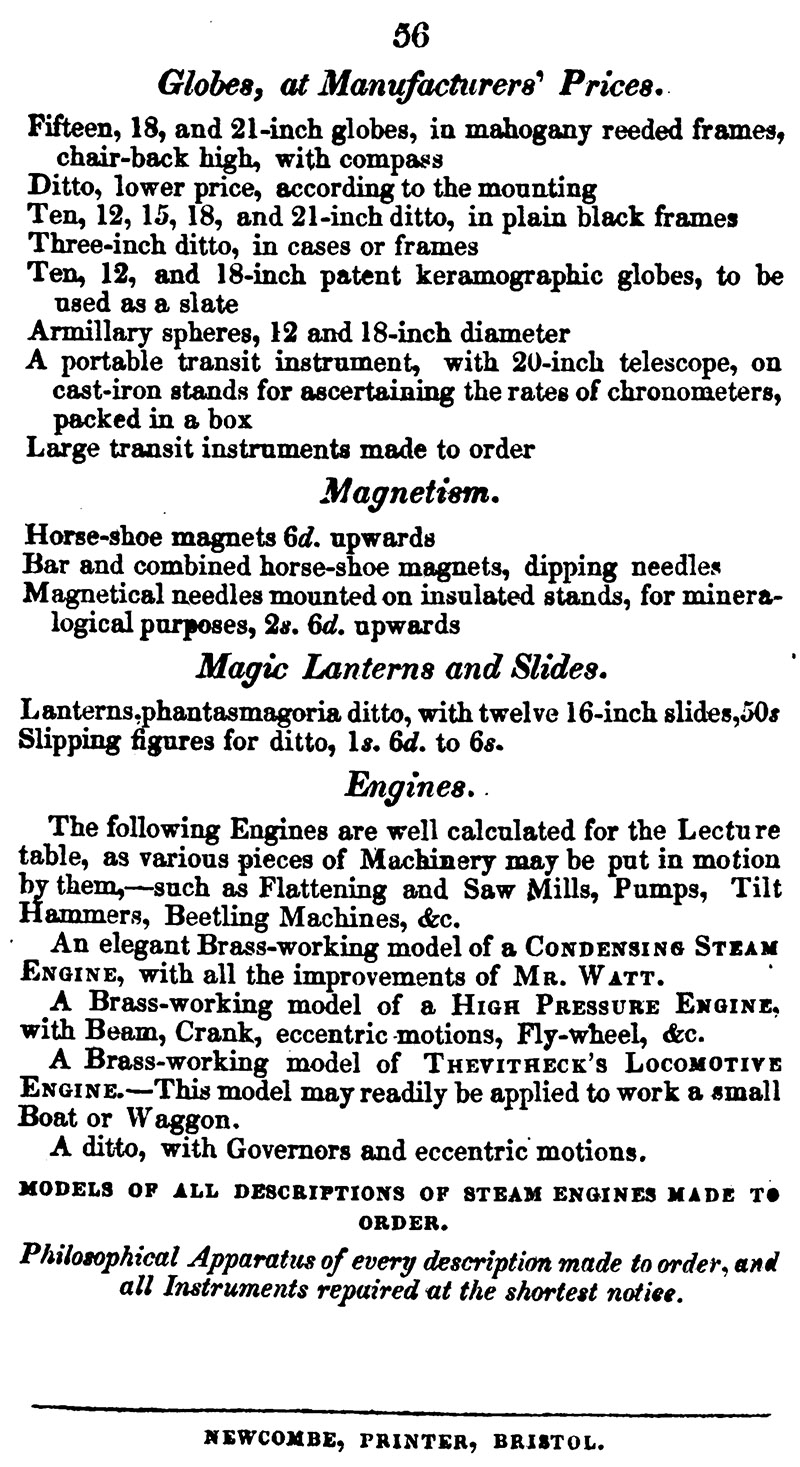
Figure 8.
John Braham’s 1837 catalogue, which accompanied his “Outlines of the Science of Magnetism, Electro-Magnetism, Voltaic, Thermo, and Magneto-Electricity”.
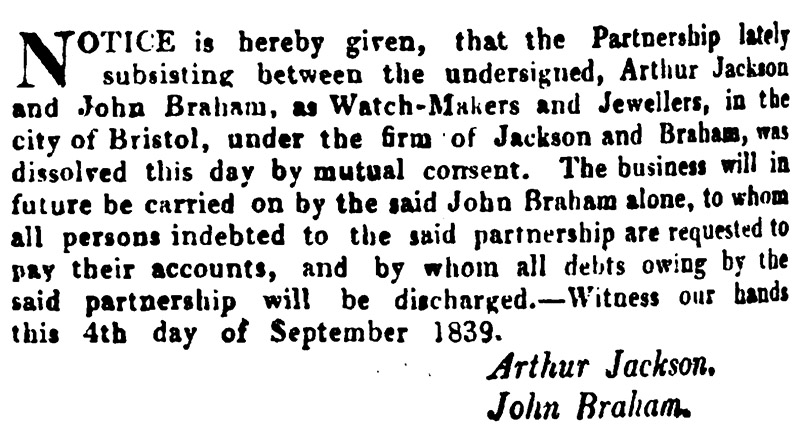
Figure 9.
An 1839 notice of the dissolution of the partnership between John Braham and Jacob Jackson’s son, Arthur. From “The London Gazette”.
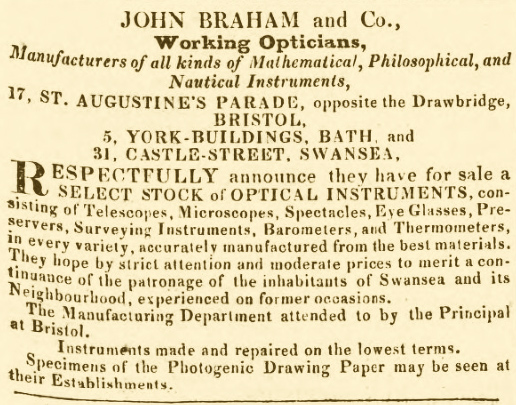
Figure 10.
An 1839 advertisement from “The Cambrian”. Note that John Braham advertised his own shop in Bristol, his brother’s in Bath, and a third location in Swansea, Wales. Nothing more is known about the Swansea operation.
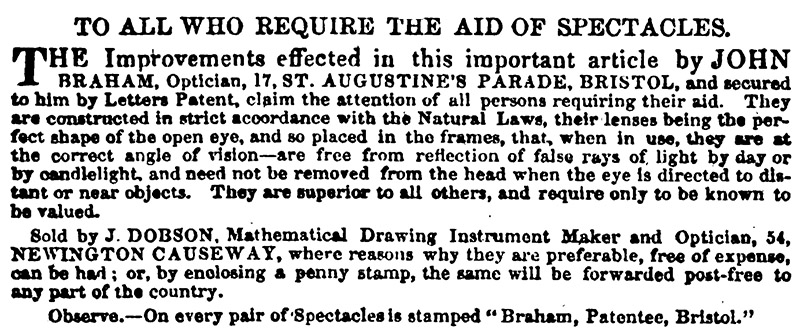
Figure 11.
An 1845 advertisement, from “The Family Herald”.
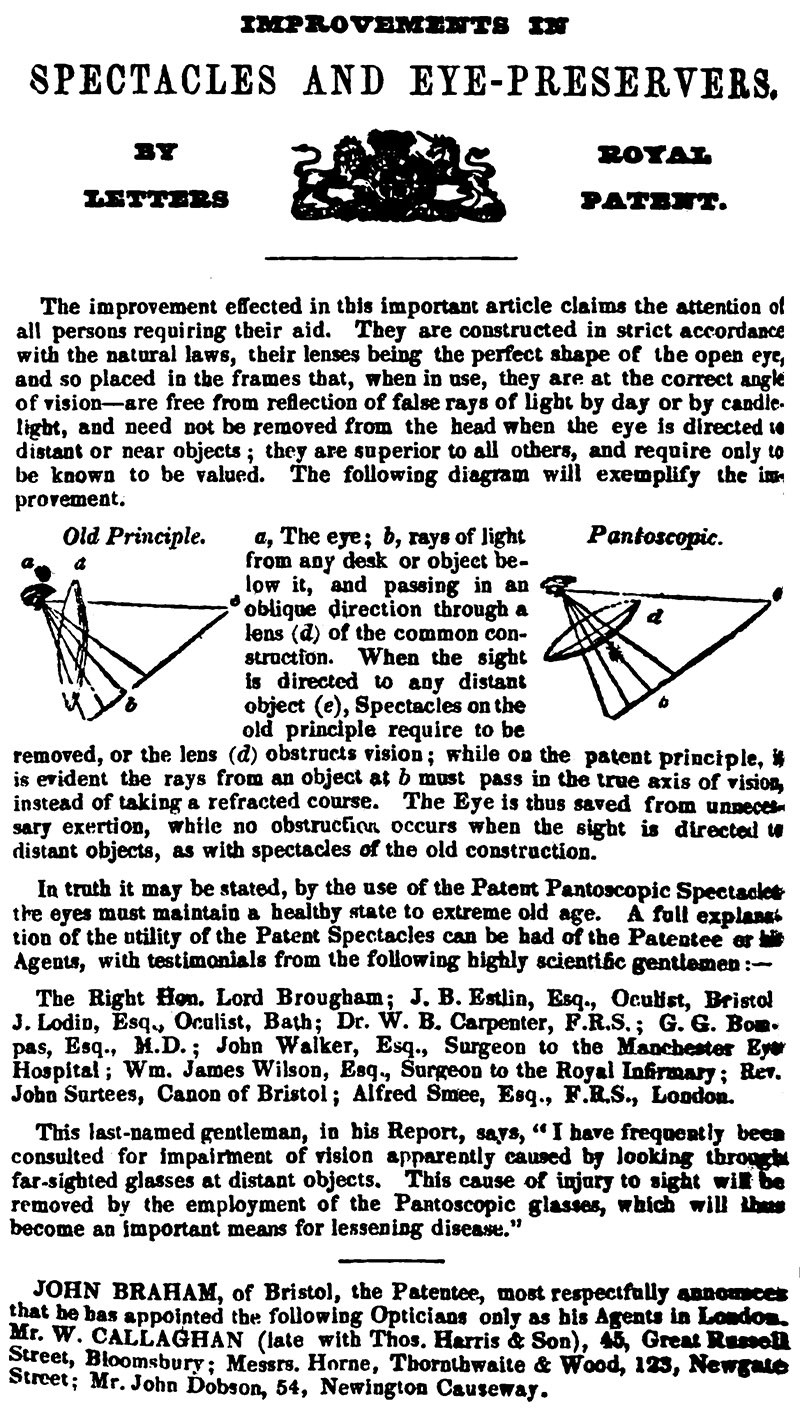
Figure 12.
An 1845 advertisement, from “The Catholic Directory”.
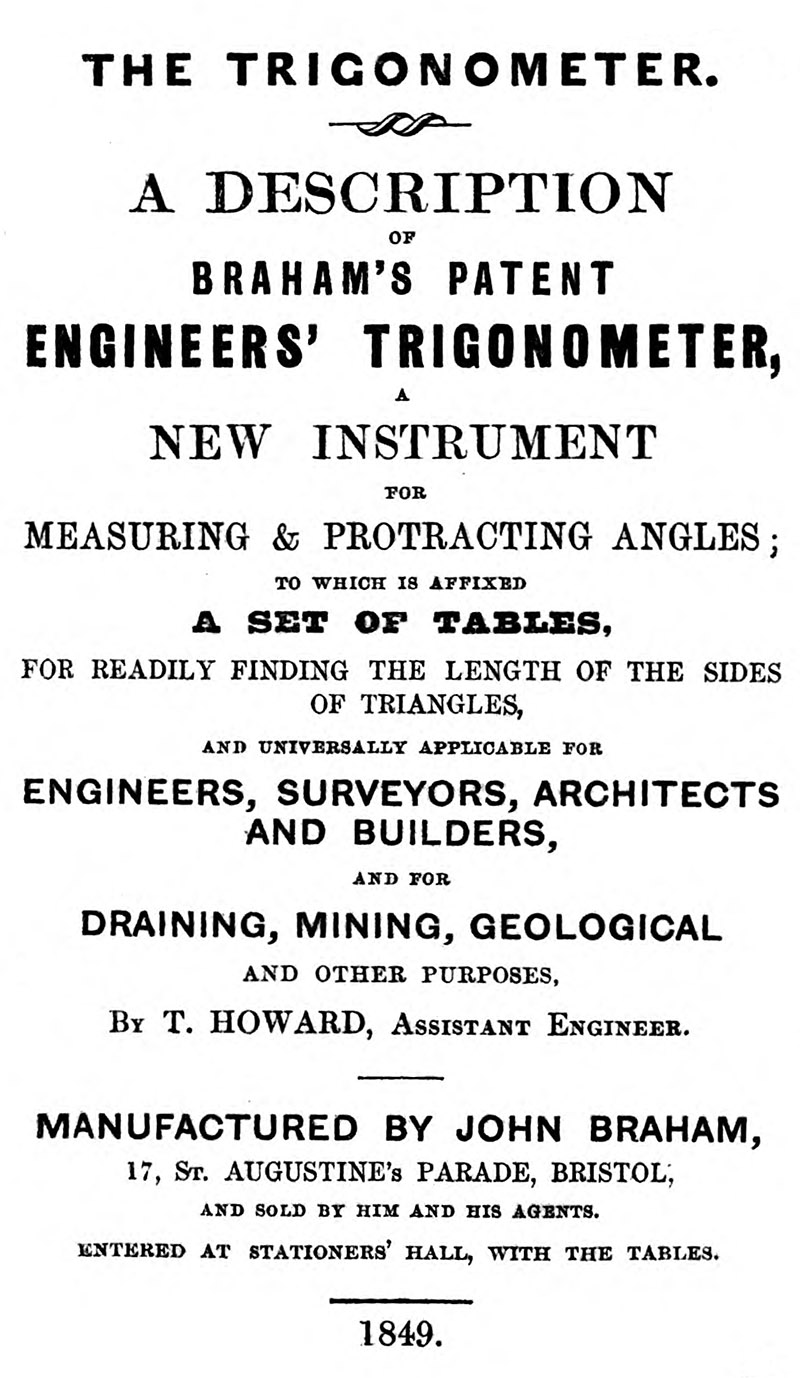
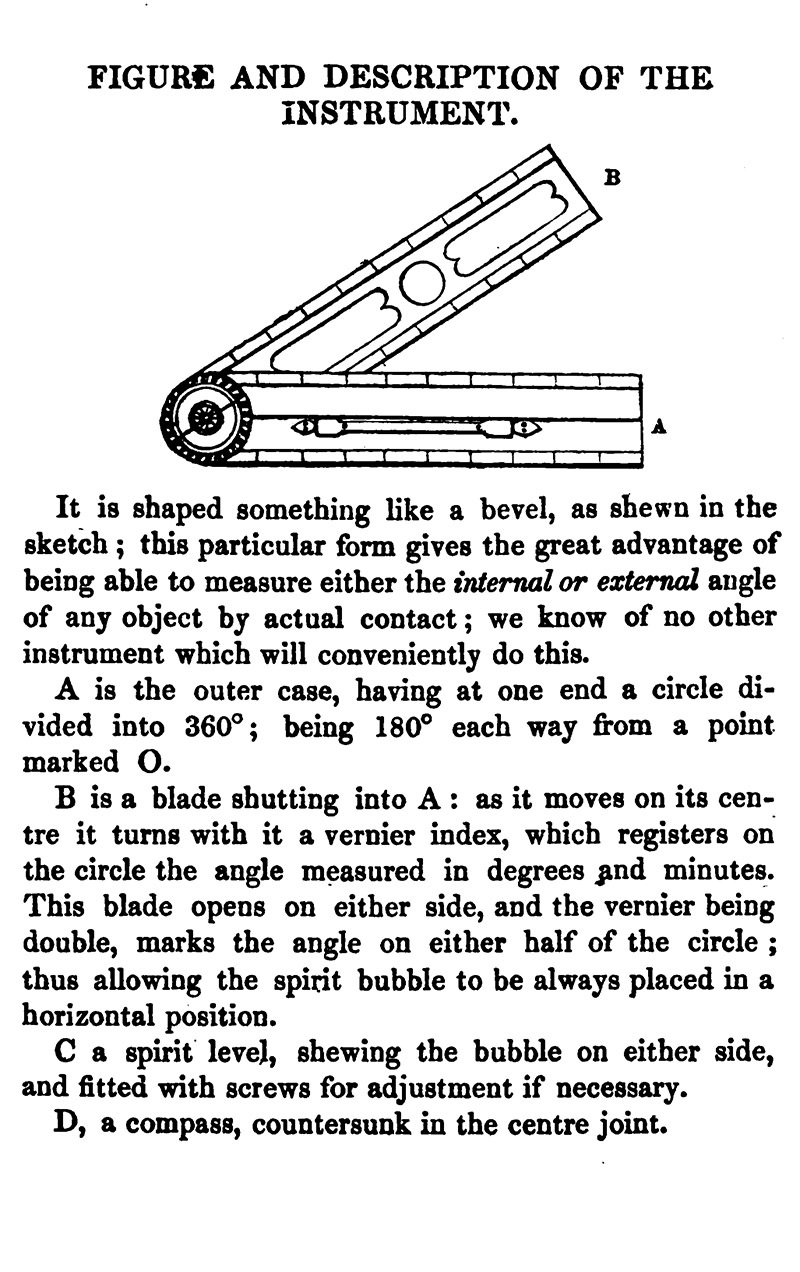
Figure 13.
Cover page and an excerpt from John Braham’s 1849 booklet on “The Trigonometer”.
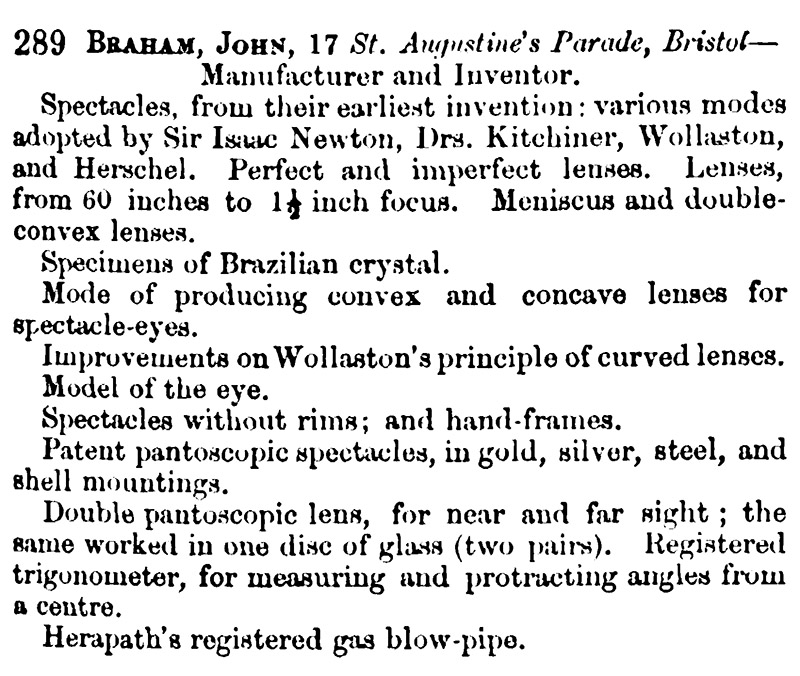
Figure 14.
John Braham’s entries in the 1851 International Exhibition of London.
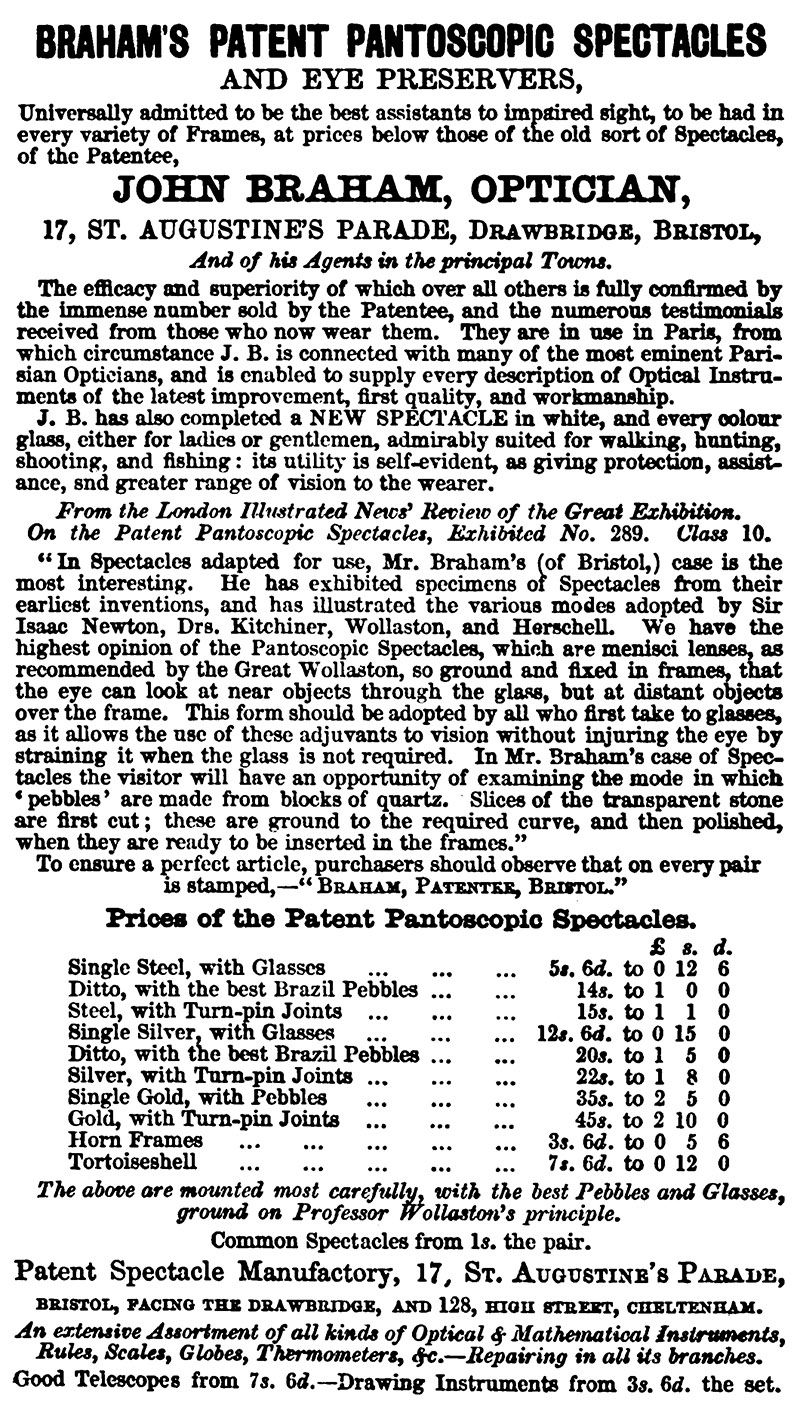
Figure 15.
An 1857 advertisement, from “Chillcott's Descriptive History of Bristol”.
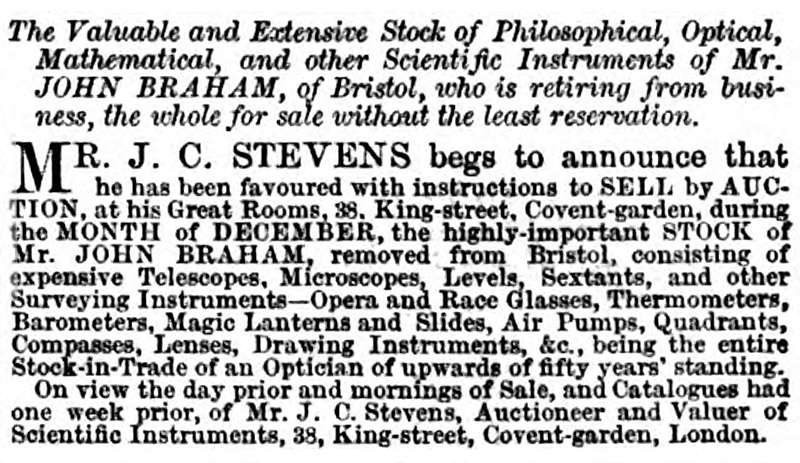
Figure 16.
1863 announcement of the auction of John Braham’s shop goods. From “The Athenaeum”.
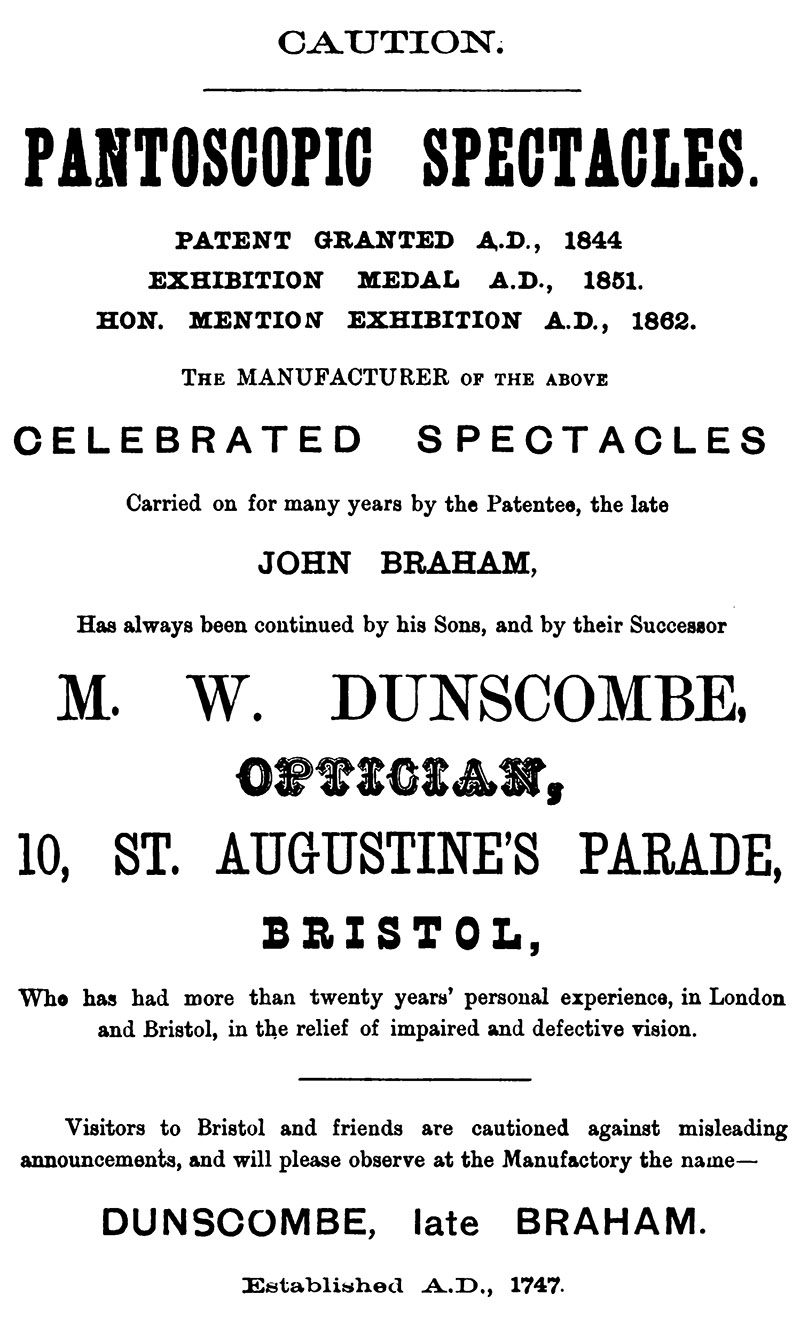
Figure 17.
An 1878 advertisement from Matthew Dunscombe.
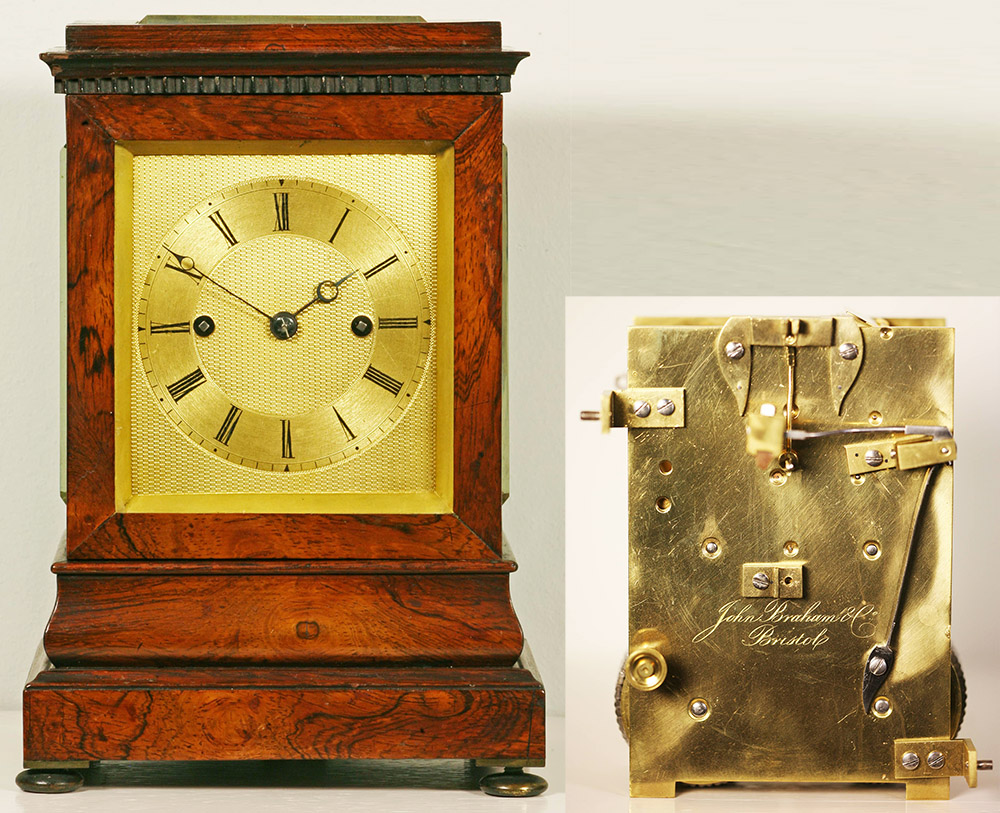
Figure 18.
A clock that is signed by John Braham & Co., Bristol. Braham took over his father-in-law’s clock-making business in 1839. Adapted for nonprofit, educational purposes from an internet auction site.

Figure 19.
An ivory ruler that was sold by John Braham. It is likely that this was brought in from a wholesale manufacturer. Adapted for nonprofit, educational purposes from an internet auction site.
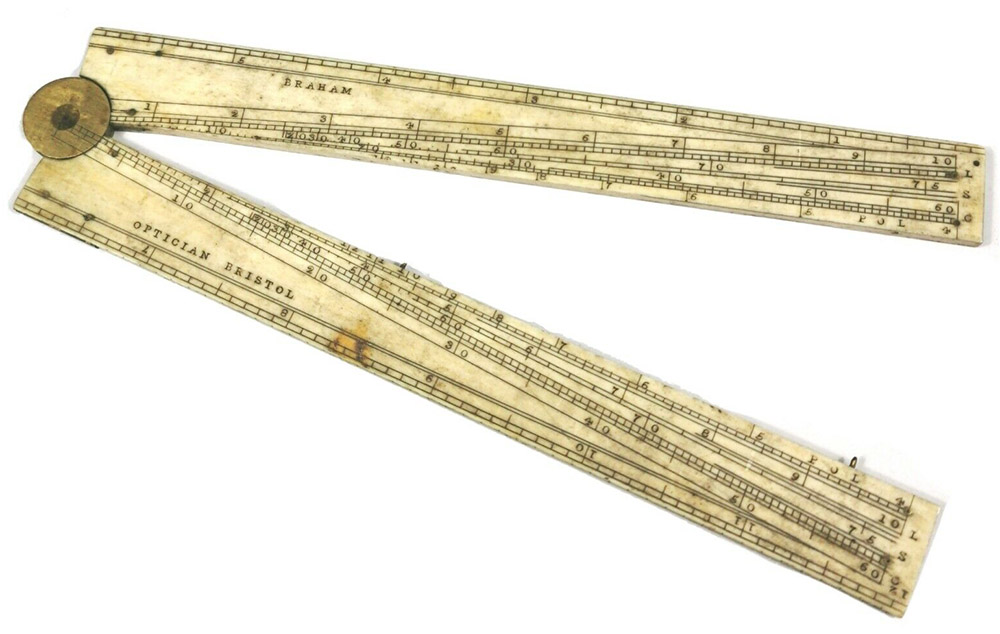
Figure 20.
An ivory sector from John Braham. Adapted for nonprofit, educational purposes from an internet auction site.

Figure 21.
A novelty thermometer from John Braham, made of turned wood and ivory. It is not clear whether the lighthouse is meant to represent a specific Bristol-area lighthouse. Adapted for nonprofit, educational purposes from an internet auction site.
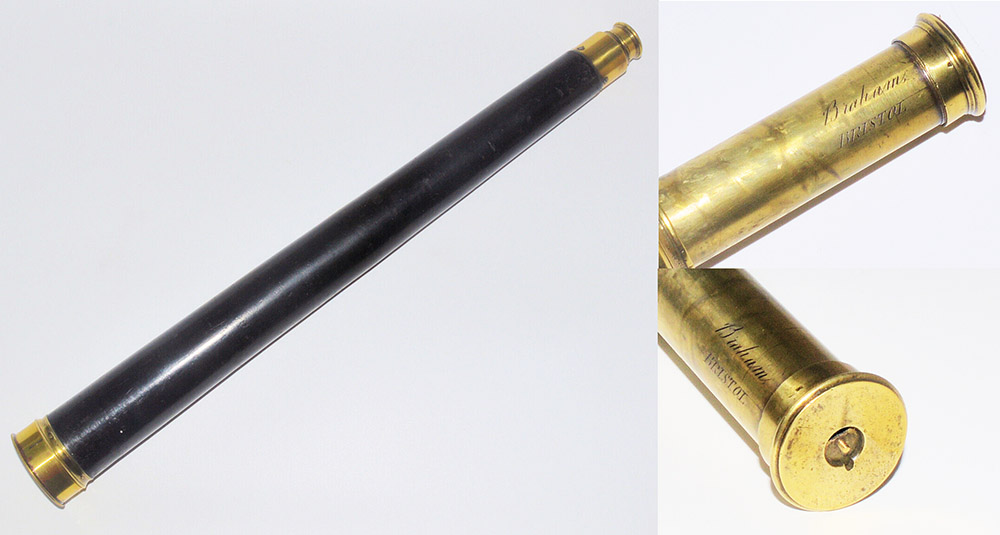
Figure 22.
Telescope that was retailed by John Braham. As with many of his other scientific instruments, it was probably acquired from a wholesale manufacturer, such as Proctor & Beilby / G. & W. Proctor. Adapted for nonprofit, educational purposes from an internet auction site.
Acknowledgements
Thank you to Joe Zeligs for sharing images from his database of antique microscopes.
Resources
Apprenticeship record of William James, with Jacob Jackson, watchmaker of Bristol, as master (1801) accessed through ancestery.com
The Athenaeum (1863) Notice of the auction of goods from John Braham, November 21, page 663
Braham, John (1832) Preventive for Cholera Morbus, Braham, Bristol
Braham, John (1837) Outlines of the Science of Magnetism, Electro-Magnetism, Voltaic, Thermo, and Magneto-Electricity, Braham, Bristol
Braham, John (1847) The Trigonometer, Braham, Bristol
The Cambrian (1839) Advertisement from John Braham & Co., August 10 issue
The "Canynge" Concise Guide to Bristol and Suburbs (1878) Advertisement from Matthew Dunscombe, Jeffries & Sons, Bristol
The Catholic Directory (1845) Advertisement from John Braham, back cover
Chilcott, Isaac E. (1857) Advertisement from John Braham, Chilcott’s Descriptive History of Bristol
England census and other records, accessed through ancestry.com
English Patents of Inventions (1861) Number 389 - John Braham
The Examiner (1852) Notice of the dissolution of Braham Brothers, Bristol, page 430
The Family Herald (1845) Advertisement from John Braham, page 410
Fry, Helen P. (2001) The Jews of Barnstaple and Bideford, European Judaism, Vol. 34, pages 4-13
The Great Exhibition of the Works of Industry of All Nations, Official Descriptive and Illustrated Catalogue, Volume 1 (1851) “289. Braham, John, 17 St. Augustine's Parade, Bristol - Manufacturer and Inventor”, page 439
London Gazette (1839) Notice of the dissolution of Jackson and Braham, page 1728
Matthews' New Bristol Directory (1795) Entry for Jacob Jackson
Matthews' New Bristol Directory (1797) Entry for Jacob Jackson
Matthews’ Annual Bristol Directory and Commercial List (1828) “Braham John, Optician; Mathematical Instrument Warehouse, 12 Clare street”, and “Jackson J. & Son, Goldsmiths, Jewelers, Chronometer, Watch and Clock manufacturers, &c. Observatory, 17 St. Augustine’s parade, nearly opposite the Drawbridge”, pages 42 and 99
Matthews’ Annual Bristol Directory and Commercial List (1836) “Braham John, Optician ; Mathematical, Philosophical, & Nautical Instrument maker, 10 St. Augustine’s parade, Agent for the sale of the Charts & Plans published by the Lords Commissioners of the Admiralty”, and “Jackson J. & Son, Goldsmiths Jewelers, Chronometers, Watch & Clock manufacturers, &c. Observatory, 17 St. Augustine’s parade, nearly opposite the drawbridge”, pages 51 and 107
The Nautical Magazine (1830) Works in navigation and nautical science, pages 34-35
Pigot & Co. New Commercial Directory (1825) “Watchmakers … Jackson J. & Son, 17 St. Augustine's-parade”, page 1263
Pigot’s Directory of Gloucestershire (1842) “Braham John, optician, 17 St. Augustine’s parade”, page 15
Probate of the will of John Braham (1864) “The will of John Braham formerly of the City of Bristol and afterwards of 95 Guildford-street Russell-square but late of 17 Doughty-street Mecklenburgh-square both in the County of Middlesex Gentleman deceased who died 14 August 1864 at Doughty-street aforesaid was proved at the Principal Registry by the oaths of Charles Desprez of Park-street in the said City Watch Maker and Lewis Braham of 17 Guildford-street aforesaid Optician the Son two of the Executors. Effects under £2000”, accessed through ancestry.com